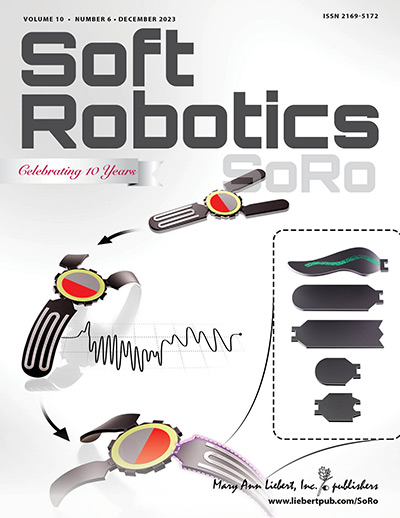Fin-A-Rays: Expanding Soft Gripper Compliance via Discrete Arrays of Flexible Structures.
IF 6.1
2区 计算机科学
Q1 ROBOTICS
引用次数: 0
Abstract
Typical soft robot grippers use a small number of "fingers," often inspired by human hands, limiting adaptability to objects. One way to increase the number of digits in the end effector is through arrays of independent flexible structures, quantizing the gripper and increasing compliance. This work investigates what happens when we "slice" a Fin Ray soft gripper into an array of discrete fingers, called Fin-A-Rays. Fin-A-Rays are modular gripper systems that can be readily integrated into an off-the-shelf two-fingered parallel gripper. Here, between one and 24 Fin Ray fingers of width 2.5 mm to 60 mm are arranged side-by-side as a gripper. An analysis of the effects of finger width on gripper stiffness and object contact is presented via finite element analysis. The design space of Fin-A-Rays was studied via experiments and simulation, and a set of performance metrics for Fin-A-Rays was defined to understand the effects of "slicing" on grasping a set of objects. A design algorithm is also introduced to prearrange a Fin-A-Ray configuration based on an image of the object. The discretized compliance across an array of fingers in a Fin-A-Ray enables several novel behaviors during grasping, including finger splay and twisting. Results show that a balance between finger widths is required when slicing Fin-A-Rays, where algorithmically designed Fin-A-Rays showed higher average performance metrics than uniform configurations. Fin-A-Rays showed new capabilities, including multiobject grasping and in-hand manipulation. The passive morphological adaptability of Fin-A-Rays simplifies grasp planning, enabling delicate grasps for picking and packing complex shapes.鳍- a -射线:通过离散阵列柔性结构扩展软夹持器顺应性。
典型的软体机器人抓手使用少量的“手指”,通常受到人手的启发,限制了对物体的适应性。增加末端执行器中位数的一种方法是通过独立的柔性结构阵列,量化夹持器并增加顺应性。这项工作研究了当我们将Fin- Ray软爪“切”成一组离散的手指(称为Fin- a - rays)时会发生什么。Fin-A-Rays是模块化夹持系统,可以很容易地集成到现成的两指平行夹持器中。在这里,宽度为2.5毫米至60毫米的1至24个鳍射线手指并排排列作为夹持器。通过有限元分析,分析了手指宽度对夹持器刚度和与物体接触的影响。通过实验和仿真研究了Fin-A-Rays的设计空间,并定义了一套Fin-A-Rays的性能指标,以了解“切片”对抓取一组对象的影响。本文还介绍了一种基于物体图像预先安排鳍-A- ray结构的设计算法。在Fin-A-Ray中,手指阵列的离散顺应性可以实现抓握过程中的几种新行为,包括手指张开和扭曲。结果表明,在切割Fin-A-Rays时需要平衡手指宽度,其中算法设计的Fin-A-Rays显示出比均匀配置更高的平均性能指标。鱼鳍- a - rays显示了新的能力,包括多物体抓取和手持操作。Fin-A-Rays的被动形态适应性简化了抓取规划,使精细的抓取采摘和包装复杂的形状。
本文章由计算机程序翻译,如有差异,请以英文原文为准。
求助全文
约1分钟内获得全文
求助全文
来源期刊

Soft Robotics
ROBOTICS-
CiteScore
15.50
自引率
5.10%
发文量
128
期刊介绍:
Soft Robotics (SoRo) stands as a premier robotics journal, showcasing top-tier, peer-reviewed research on the forefront of soft and deformable robotics. Encompassing flexible electronics, materials science, computer science, and biomechanics, it pioneers breakthroughs in robotic technology capable of safe interaction with living systems and navigating complex environments, natural or human-made.
With a multidisciplinary approach, SoRo integrates advancements in biomedical engineering, biomechanics, mathematical modeling, biopolymer chemistry, computer science, and tissue engineering, offering comprehensive insights into constructing adaptable devices that can undergo significant changes in shape and size. This transformative technology finds critical applications in surgery, assistive healthcare devices, emergency search and rescue, space instrument repair, mine detection, and beyond.
 求助内容:
求助内容: 应助结果提醒方式:
应助结果提醒方式:


